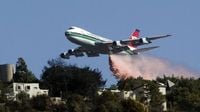In the early hours of Saturday, April 26, 2025, an explosion rocked Raja'i Port, Iran's largest commercial port, resulting in a tragic death toll that has now risen to 28. The explosion, which occurred around 8:30 GMT, was powerful enough to be heard several kilometers away, prompting immediate emergency responses and widespread concern about the safety of hazardous materials stored at the facility.
Russian President Vladimir Putin expressed his condolences to Iranian Supreme Leader Ali Khamenei and President Massoud Bazshkian following the disaster. According to the Russian embassy in Tehran, Putin has directed the Russian Ministry of Emergency Situations to send aircraft to assist with the aftermath of the explosion and help contain the fire that continues to rage at the port.
The explosion occurred at Raja'i Port, a critical hub for Iran's economy, where approximately 85% of the country's goods are processed. Located about 23 kilometers west of Bandar Abbas and near the strategically significant Strait of Hormuz, the port plays a vital role in international trade, especially concerning oil exports. The port is described by the official IRNA news agency as "the largest and most modern container port in Iran," featuring 12 berths and 30 types of advanced equipment.
As rescue operations continue, reports indicate that over 1,100 individuals have sustained injuries from the explosion. The Iranian state television has confirmed that at least 25 people have lost their lives, while judicial officials in the Hormozgan Governorate provided similar figures. Search and rescue teams are working tirelessly to locate any remaining victims and assess the full extent of the damage.
Preliminary investigations suggest that the explosion may have been caused by the improper storage of hazardous materials and chemicals within the port area. The official media has quoted the Red Crescent, emphasizing the potential dangers associated with such materials. Additionally, a source linked to the Iranian Revolutionary Guard, who requested anonymity, indicated that the explosion was likely triggered by sodium perchlorate, a chemical compound commonly used in solid rocket fuel.
The ramifications of this incident extend beyond immediate casualties and injuries. The port's operations, which are crucial for Iran's economy, may face significant disruptions in the wake of the explosion. With ongoing tensions in the region and the global implications of oil supply routes, the situation at Raja'i Port is being monitored closely by international observers.
As the investigation unfolds, officials are under pressure to determine the exact cause of the explosion and to implement measures that ensure the safety of hazardous materials in the future. The Iranian government has not yet provided a timeline for when operations at Raja'i Port might return to normal, leaving many in the region anxious about the economic impact of this disaster.
This incident highlights the vulnerabilities faced by major industrial ports, particularly those handling hazardous materials. Experts warn that without stringent safety protocols, the risk of such catastrophic events remains high. The international community is watching closely, as the implications of this explosion could resonate well beyond Iran's borders.
In the coming days, as recovery efforts continue, the focus will also shift towards ensuring that the families of the victims receive the support they need. The Iranian government has pledged to assist those affected by this tragedy, but the full scope of aid and recovery efforts remains to be seen.
As the dust settles on this tragic event, one thing is clear: the explosion at Raja'i Port serves as a stark reminder of the potential dangers associated with industrial operations, particularly in regions where geopolitical tensions are already high.




